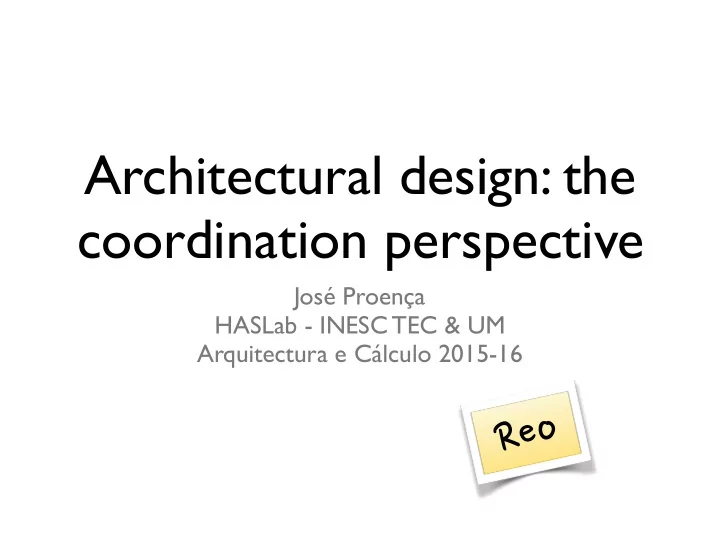

Architectural design: the coordination perspective José Proença HASLab - INESC TEC & UM Arquitectura e Cálculo 2015-16 O F :
Software architecture for reactive systems There is no general-purpose , universally tailored , approach to architectural design of complex and reactive systems �N�TI�S�DO�RSF� �NTROE�DF�E���FRFNT�MOEFLS��OR�RFBDT�VF�SYSTFMS E�SD�SS�TIF�R�BRDI�TFDT�RBL�EFS�HN W�TI��RFBSONBCLF��TOOL�S�PPORT��OR�MOEFLL�NH�BNE�BNBLYS�S
Models of Concurrency Traditional models are action-based Petri nets Work flow / Data flow Process algebra / calculi Actor models / Agents … Interaction appears as an implicit side-effect; Makes coordination of interaction more difficult to Specify Verify Manipulate Reuse
Interaction with process algebra act g, r, b, d : String % synchronisation points �OEFL�DONSTR�DTFE�CY� print, genG, genR; DOMPOS�NH�BDT�ONS��NTO� proc MORF�DOMPLF��BDT�ONS B = b(t) . print(t) . d("done") . B G = g(k) . genG(t) . b(t) . d(j) . r(k) . G R = r(k) . genR(t) . b(t) . d(j) . g(k) . R >IFRF��S�TIF� init G || R || B || g("token") ���1:-�����,
Interaction with Object Oriented Software • In OO the architecture is implicit : source code exposes class hierarchies but not the run-time interaction and configuration • Objects are wired at a very low level and the description of the wiring patterns is distributed among them The semantics of method invocation is heavy and non-trivial: • The caller must know the callee and the method. • The callee must (pretend) to interpret the message. • The caller suspends while the callee (pretends to) perform the method and resumes when the callee returns a result.
Implicit interaction Interaction (protocol) is implicit in action-based models of concurrency Interaction is a by-product of processes executing their actions Action a of process A collides with action b of process B Interaction is the specific (timed) sequence of such collisions in a run Interaction protocol is the (timed) sequence of the intended collisions in such a sequence. �OW�DBN�TIF�SF��FNDF�O�� �NTFNEFE�DOLL�S�ONS��TIF� �NTFRBDT�ON�PROTODOL��DBN�CF� �OW�DBN�TIF��NTFNEFE� �BN�P�LBTFE,� �FR���FE,� BNE�TIF�DO�ND�EFNTBL�CF� 0FC�HHFE,� E���FRFNT�BTFE, :F�SFE�,
Interaction with components Shift from class inheritance to object composition Avoid interference between inheritance and encapsulation and pave the way to a development methodology based on third-party assembly of components Move from an action-based to an interaction-based model of concurrency .LBD��CO�� �BNVBS�TO� �ONNFDT�ONS� DOMP�TBT�ON� EROP�TIFM V�B�W�RFS �N�TS
Component coordination in Reo Wr connector Rd Wr • Exogenous coordination • Synchronous (atomic) • Compositional (channel • Coordination is based) constrained interaction ��FTFR�>FHNFR��)���A
Component coordination in Reo Endogenous: provide primitives that must be incorporated within a computation for its coordination Wr Exogenous: ensure that the conceptual separation connector Rd between computation and coordination is suitably Wr respected • Exogenous coordination • Synchronous (atomic) • Compositional (channel • Coordination is based) constrained interaction ��FTFR�>FHNFR��)���A
Discrete atomic steps Ready to write! Ready to receive! Wr connector Rd Wr N o d a t a y e t . . .
Discrete atomic steps Go! Take data. Wr connector Rd Wr Wait.
Reo: Channel composition
Reo ✦ Language for compositional construction of interaction protocols ✦ Interaction is the only first-class concept in Reo: ✦ Explicit constructs representing interaction ✦ Composition operators over interaction constructs ✦ Protocols manifest as a connectors ✦ In its graphical syntax, connectors are graphs ✦ Data items flow through channels represented as edges ✦ Boundary nodes permit (components to perform) I/O operations ✦ Formal semantics (various formalisms - shown later) ✦ Tool support: draw, animate, verify, compile
Composition as coordination • interacting components need not know each other. (cf traditionally communication is targeted, making the sender semantically dependent on (the scheme used to identify) the receiver) • communication becomes anonymous: components exchange identifiable sequences of passive messages with the environment only • therefore third parties can coordinate interactions between senders and receivers of their own choice
Components • loci of computation • are kept independent of each other and of their environment • Components communicate with the environment only through read and write operations on the connector ends (or ports), possibly according some behavioural interface description
Connectors • act as interaction controllers: the glue code that makes components interact • i.e., they coordinate the activities of individual components to ensure their proper interaction with one another to form a coherent system that behaves according to its requirements • have no relevant role in the computation carried out by the overall system: they are component-independent and agnostic wrt the underlying computation model • provide systems-independent interaction protocols (whereas components provide systems-specific functionality) • … built compositionally. • but traditionally, glue code is the most rigid, component specific, special purpose software in component based systems!
Reo connectors • Source end: through which data enters the connector • Sink end: through which data comes out of the connector 1�BMPLFS� Sync SyncDrain SyncSpout LossySync AsyncDrain AsyncSpout FIFO 1 FIFO 1 (x)
Composing Reo connectors join a b b c ⨝ source ends b with = a c sink ends ONF�TO�ONF Nodes: syntactic sugar for mergers and replicators MFRHFR RFPL�DBTOR SO�RDF�NOEFS S�N��NOEFS M��FE�NOEFS
Reo eclipse toolset HFT�1DL�PSF �PEBTF�S�TF� http://reo.project.cwi.nl/update
Recommend
More recommend